 Image taken from the short film “Sea rescue is not a crime” by Primitivi.
Image taken from the short film “Sea rescue is not a crime” by Primitivi.
I. Introduction
In 2019, fewer than 15,000 people succeeded in crossing the central Mediterranean Sea. Merely around 11,500 people reached Italy by boat, and about 3,300 Malta, mostly fleeing from Libya or Tunisia. These figures highlight a dramatic decrease – from 181,436 arrivals in 2016, 119,369 in 2017, and 23,370 in 2018. This decrease reflects not a diminishing need to escape but instead the growing ability of Europe and its African allies to close down migration routes and to violently prevent departures or capture those at sea and force them back to North African coasts.
Still, despite such decrease, the Alarm Phone has never before received as many distress calls from this central Mediterranean region proportional to the number of departures. Whereas in 2018, 27 boats reached out to us from this region, 101 boats reached out to us in 2019, carrying over 6,200 people. What we heard in all these distress cases were voices of people who desperately tried to survive and who feared to be returned to the torturous conditions in Libya. People who, against all odds, struggled on and showed such tenacity and longing for freedom while navigating their boats toward Europe.
2019 began with mass fatalities at sea. On the 18th of January, 117 people died off the coast of Libya. Over the course of the year, 743 deaths have been recorded along this central Mediterranean route but we know that there were hundreds more – organisations such as the IOM or UNHCR that compile statistics on border deaths have ignored several of the shipwrecks that we have reported on. Over the year, we have witnessed mass refoulement and interception operations, particularly by the so-called Libyan coastguard. About 9,000 people are said to have been intercepted and forcibly returned to a war zone, including by commercial vessels such as the Lady Sham, which refouled 144 people back to Libya on January 21. Many of these interceptions were coordinated by Europe, by European coastguards, by Eunavfor Med or Frontex, who were often present at scenes of distress, but merely up in the air so that interceptions could be coordinated without being ‘forced’ into conducting rescues to Europe. What has also continued throughout 2019 were attempts to criminalise and de-legitimise NGO rescuers, and to thereby push out witnesses of mass human rights violations perpetrated by Europe and its allies at sea.
Still, despite all the atrocities we have witnessed in the Mediterranean over the year, we have also witnessed thousands-fold enactments of the freedom of movement. We have seen how boats have arrived autonomously on European shores, and how NGO rescuers returned to the sea, again and again, and against all odds. We saw how migrant travellers, such as the “El Hiblu Three”, resisted being returned to places of torment and unfreedom.[1] New forms of solidarity ‘on the move’ have been built, from the sea to the cities. For the coming year, we promise to continue with our struggle against death at sea, together with those on the move, the civil fleet, fishermen in north Africa, social movements, civil society and sympathetic municipalities and cities. We will not cease to demand: Ferries not Frontex!
II. Developments in the Central Med
Between the 1st of October and the 31st of December, the period of time covered in this analysis, we have seen continuous collective struggles by migrants, activists and NGOs in the central Mediterranean Sea. On part of Europe and its northern African allies, we have seen practices of non-assistance, delayed rescues, interceptions and refoulements to Libya.
Rescues by the Civil Fleet and Alarm Phone
Over the past three months, members of the civil fleet have returned several times to the central Mediterranean to carry out life-saving rescues – many of which involved the Alarm Phone. On the 6th of October, the Open Arms rescued 40 people off a wooden boat.[2] Between the 12th and 13th of October, the Ocean Viking rescued two boats both of which had contacted the Alarm Phone, carrying 74 and 102 people.[3] On the 26th of October, the Alan Kurdi rescued 92 people who had called the Alarm Phone – during the rescue procedure they were severely obstructed and threatened by Libyan forces.[4] On the 19th of November, the Ocean Viking rescued 94 people after the Alarm Phone had relayed their distress. Ocean Viking’s crew rescued also a boat carrying 30 people who had reached out to us.[5] On the 28th of November, the Alarm Phone was alerted by three boats in distress – all of them were rescued by the civil fleet, two by the Alan Kurdi carrying 44 and 40 people, and one by the Ocean Viking, carrying 60 people.[6] Returning once more to the sea, Ocean Viking rescued 112 and 50 people on the 20th/21st of December – both boats had alerted the Alarm phone.[7] The 162 rescued people included about 50 minors, and some said after their rescue that they had survived the air strike on the notorious Tajoura camp where they had been held captive.[8] On the 27th of December, the Alan Kurdi rescued 32 people who had escaped Libya and called the Alarm Phone.[9]
After several of these rescue operations, the civil fleet had to wait for many days to be assigned a safe port in Europe – the suffering of the rescued was thereby unnecessarily prolonged.[10] Fortunately, another member of the civil fleet is returning to the central Mediterranean. On the 19th December, Sea-Watch3 was finally released and its crew set sail to the death-zone off the coast of Libya on the 30th of December.[11]
This infographic highlights the crucial role that the civil fleet plays in the central Mediterranean. In November 2019, over 90 percent of the people who fled Libya and arrived in Europe were rescued by an asset of the civil fleet.
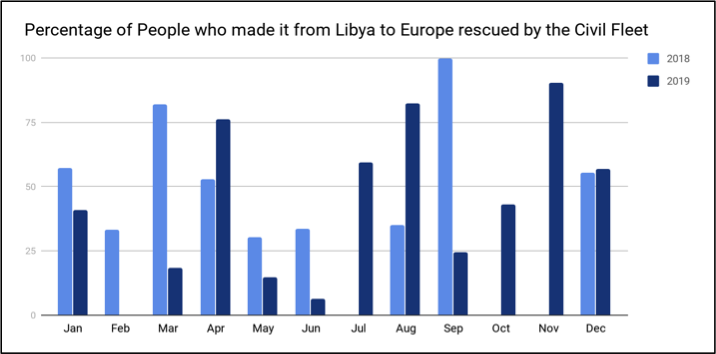
Non-Assistance, Delays, Interceptions, Refoulements
Some of the boats that reached out to the Alarm Phone were rescued by European coastguards after reaching the European SAR zones independently. While, at times, we experienced swift action, as on the 14th of October when a boat had come very close to Lampedusa and was then rescued by the Italian coastguards, we repeatedly experienced delays in rescue as well as inadequate or outright illegal behaviour on part of the European authorities.[13]
On the 14th of October, a boat with 76 people on board was rescued by the Maltese authorities after many hours of inaction and conscious delays in carrying out the rescue operation.[14] As outlined in depth later on, Malta orchestrated an interception of a boat in distress from its own Search and Rescue zone on the 18th of October. The 50 people who had called us were abducted back to Libya by the Libyan militia.[15] RCC Malta is responsible for the violation of both SAR conventions and human rights conventions.[16] Although this case received a lot of attention in the media, we have not yet seen any repercussions for Malta. The UNHCR promised to launch an investigation, but we still have not heard of any steps taken.
Although public scrutiny of Malta’s role in the Mediterranean has increased, not least after the secret deal between Malta and Libya on preventing migrant arrivals was exposed in November, Malta continues to delay rescue operations and rejects responsibility for people in urgent distress at sea.[17] On the 21st of November, 94 people fleeing from Libya alerted us when their rubber boat was deflating. Italy and Malta were alerted but they refused to take responsibility. Two NGO vessels, the OpenArms and the AitaMari, searched all night in vain.[18] On the 29th of November, we were called by about 70 people on a wooden boat in the Maltese SAR zone. We contacted both Italy and Malta but they would not confirm whether they had sent rescue assets out. Water was entering their boat and the people were in panic. We lost contact and never heard from them again.[19] These two boats are still missing, and we fear that they capsized.
Many boats that reached out to us were intercepted back to Libya, often after being spotted by European air assets that have become crucial in the interception and refoulement industry off the coast of Libya. Some were also returned by merchant vessels, as we explore in detail further below. As the newly report by Forensic Oceanography highlights, such “refoulement by proxy” practices are by no means uncommon.[20] This year, thousands of people have been forcibly returned to an active warzone, a place where conflicts between different warring factions have once more intensified over recent weeks.
Shipwrecks and Selective In/Visibility
We do not know how many people have lost their lives in the central Mediterranean Sea over the past three months. What we do know is that the official statistics produced by international organisations that are integral to the violent European border regime, including the IOM, are deeply flawed. They may include shipwrecks that were officially registered by European or north African authorities, as was the case for the shipwrecks that occurred on October 7 and November 23 near Lampedusa with over 50 fatalities,[21] but they will not include shipwrecks that were witnessed by credible sources, such as Libyan fishermen who gave us, for example, a concise account of a shipwreck that occurred on the 21st of November.[22] The fishermen rescued about 30 people, but stated that about 70 people had drowned. As these 70 deaths will not appear in official statistics, they are invisibilised and erased – and this is the case for hundreds of lives lost in the Mediterranean this year alone.
While shipwrecks are invisibilised, migrant boats still moving toward Europe are meant to be visibilised in order to prompt their interception by Libyan militias. The Mediterranean is being monitored by European aerial assets and drones – often operated by EU member states such as Italy and Malta, or European actors such as Frontex and Eunavfor Med. This process of visibilisation is, however, merely selective. The mass human rights violations that ensue are, of course, not meant to reach the public. Besides assisting boats in distress, the Alarm Phone’s role is precisely to counter Europe’s selective visibility: making shipwrecks that are being erased visible and highlighting the human rights violations that Europe does not want anyone to see. In order to do so, we listen to migrant travellers and fishermen – their credible first-hand testimonies have allowed us to expose mass interception campaigns, even within European SAR zones, and acts of non-assistance that have ended in mass drownings.
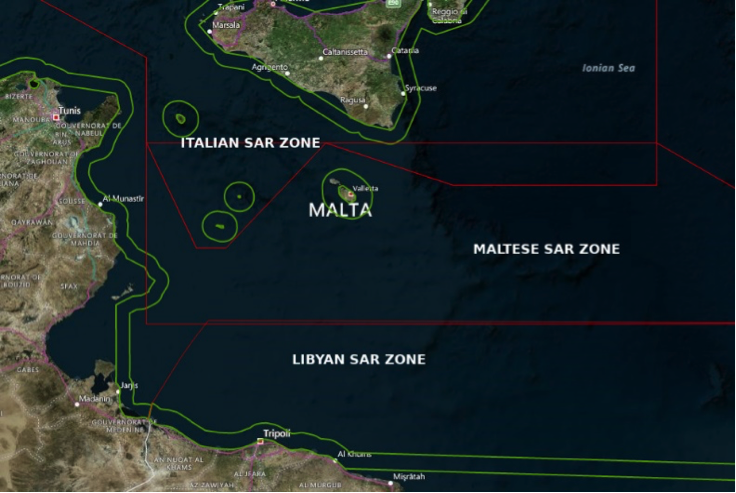
III. The Borderisation of SAR Zones
That a place of safety (POS) is assigned to vessels that have rescued people escaping from Libya should be a straightforward process, leading to disembarkation in Europe and the possibility of claiming asylum there. However, European authorities tie the assignment of a POS to the SAR zone where the rescue took place. For example, for boats in distress rescued in the disputed Libyan SAR zone, EU member states commonly refer to the so-called Libyan coastguards as the ‘competent’ authority that should organise the return of those escaping to Libya – in full knowledge of the inhuman situation there. European member states have ceased to conduct any rescues inside this Libyan SAR zone – the only actors still operating in there are members of the civil fleet, commercial vessels, and the so-called Libyan coastguard. Europe’s presence is reduced to its aerial monitoring missions to coordinate interceptions.
Regularly, the so-called Libyan coastguards assign Tripoli as POS to NGO vessels, which the NGOs of course have to refuse, as Tripoli is not safe. The NGOs then demand a POS in Europe.[23] A regular mechanism, promised after the Malta summit in September 2019, is still not on the horizon. The area of the Libyan SAR zone is legally defined as international waters and therefore states do not have exclusive jurisdiction there.[24] As Libya is not a POS, any returns of migrants back to Libya are illegal.[25] Several legal cases have been launched against Italy and the EU to end the illegal cooperation between them and Libya (see further below).
Each assignment of a POS in Europe for a vessel of the civil rescue fleet with rescued people from within the Libyan SAR Zone is handled as a “humanitarian” exception, which usually means a long standoff at sea. Although standoffs of ten days or longer are not as common anymore, standoffs of several days are still frequent. From August to November 2019, NGO vessels had to wait on average for 5.9 days at sea after rescuing in the Libyan SAR zone until they were able to disembark in Malta or Italy.
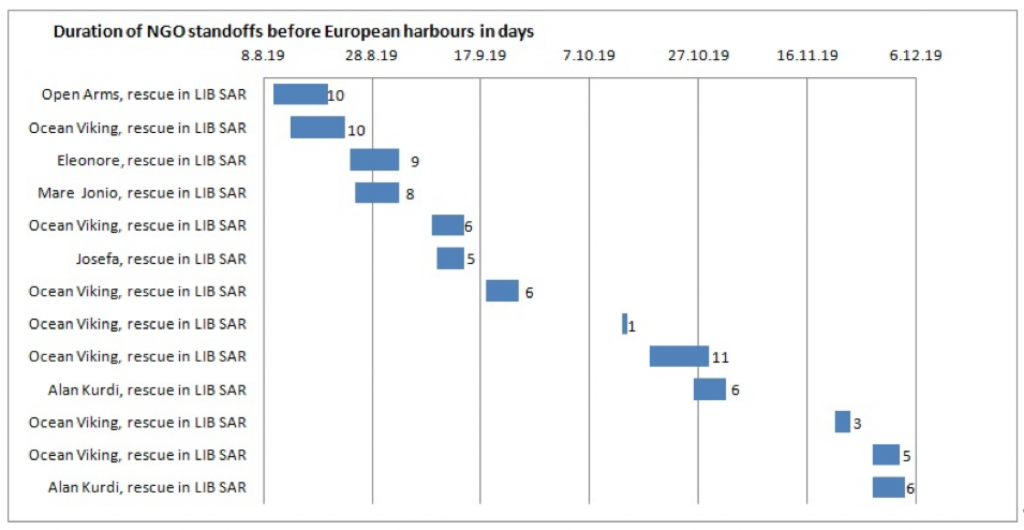
Rescues from within the SAR zones of Malta and Italy result in quicker disembarkations. Following the Salvini ‘era’, ports in Italy have become more accessible again which also had positive consequences in terms of the accessibility of Maltese ports. Nonetheless, Malta and Italy continue to do what they can to prevent migrants even reaching their SAR zones, also by concluding bilateral agreements with Libyan authorities. The ‘Memorandum of Understanding’ between Italy and Libya from February 2017 to prevent migrant arrivals in Italy was renewed in November 2019 – the current Italian government collaborates with Libya in the same manner as the Italian government did under Conte and Salvini.[26]
On the 10th of November 2019, another deal came to light: Investigative news reports revealed an agreement that Malta and the so-called Libyan coastguards had concluded in June 2019. According to this deal, Malta would inform the Libyan authorities about migrant boats moving toward Malta so that the Libyans could intercept them before reaching the Maltese SAR zone and return them to Libya instead.[27] In order to detect these boats in time, the Armed Forces of Malta (AFM) would undertake regular surveillance flights between the Libyan coast and the Maltese SAR zone. Other EU member states, particularly Italy, and EU actors (Eunavfor Med and Frontex) support this aerial surveillance actively, with an armada of aerial assets. In this way, EU member states and institutions are directly responsible for 7,012 people being forcibly intercepted and returned to Libya, from the beginning of 2019 to the end of October.[28]
As the Alarm Phone could reveal, the Malta-Libya collaboration goes even further than that. On the 18th of October, about 50 people reached out to us from within the Maltese SAR zone. As we have thoroughly documented, though sending aerial assets to monitor the boat in distress, Malta did not send out rescue assets but instead waited for the so-called Libyan coastguard to intercept the boat from within the Maltese SAR zone and abduct the people back to Libya.[29] This practice of refoulement from within a European SAR zone is not an exception, however. In a media report, an officer of the so-called Libyan coastguards frankly admitted that they would often intervene within European SAR zones.[30]
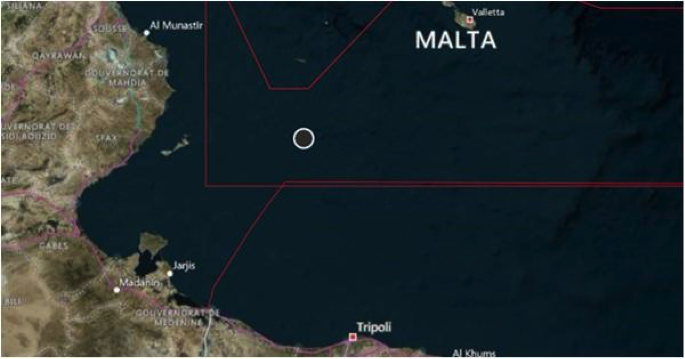
Our relays of distress situations to authorities (MRCC Rome and RCC Malta) often remain unaddressed, as they tend to refuse responsibility and instead merely tell us to inform the ‘competent’ authorities, the so-called Libyan coastguards, who are mostly not reachable via phone or email and, in any case, do not fulfil requirements to be a MRCC according to IMO statutes. Often also the Italian and Maltese authorities are not reachable for us or do not respond to us in an adequate way, e.g. by not sharing basic information with us – clearly failing in their task as official MRCCs to take action in case of on-going distress situations in the Mediterranean.
Independent Boat Arrivals in Europe
In light of the ‘interception and refoulement industry’ off the coast of Libya, people are seeking to go beyond the Libyan SAR zone in order to reach the Italian or Maltese SAR zones. This means that they have to travel for a much longer duration and expose themselves for longer to the risks at sea. For example, the distance from the Libyan coast to the Maltese SAR zone is about 100 nautical miles.
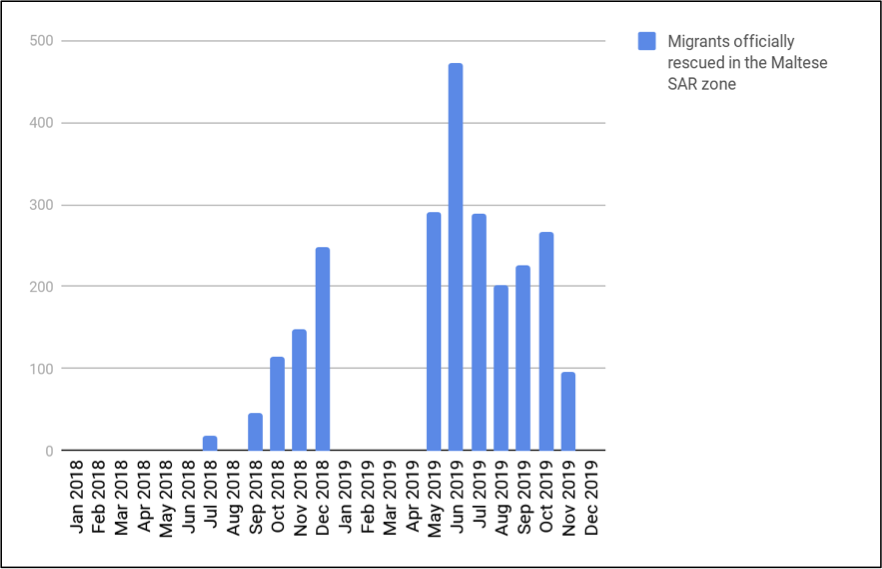
Independent arrivals in Italy have occurred also in the last months of the year – yet mostly unseen by the public. Until the end of November 2019, about 5,600 people have reached Italy autonomously. Usually, people from Tunisia, Algeria, Turkey or Greece navigate on comparably better-equipped boats than people leaving from Libya. Rubber boats leaving from Libya rarely reach European coasts independently. We experienced an exceptional case on the 19th of October when we were called from a small rubber boat coming from Zawiya in Libya – the 45 people reached Lampedusa by themselves.
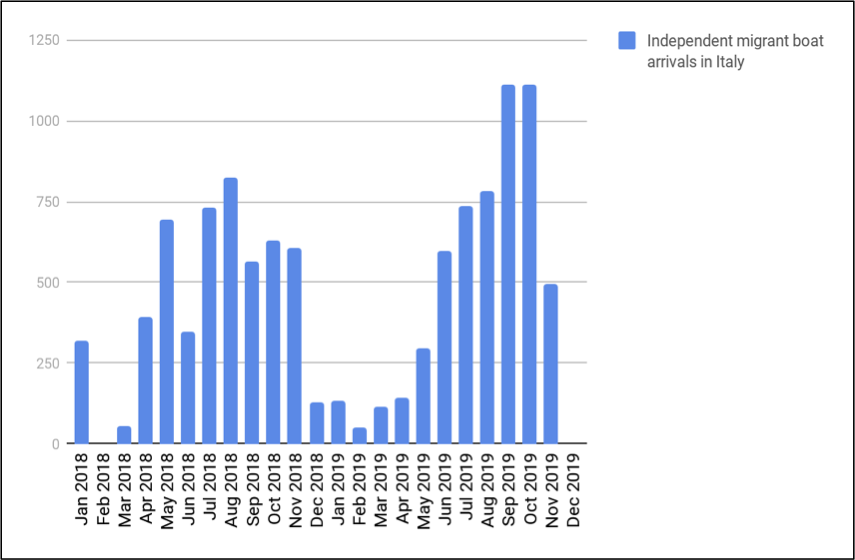
IV. “Privatised push-backs” to Libya
On the 18th of December 2019, Forensic Oceanography published a new report on privatized push-backs: the use by Italy of merchant ships to push-back migrants to Libya, a practice that was consolidated under Salvini. Among many other sources, case reports by the Alarm Phone were used for this investigation.[31] The report is the basis for a complaint in front of the UN Human Rights Committee filed by GLAN.[32] In the introduction, the report states:
“In November 2018, five months after Matteo Salvini was made Italy’s Interior Minister, and began to close the country’s ports to rescued migrants, a group of 93 migrants was forcefully returned to Libya after they were ‘rescued’ by the Nivin, a merchant ship flying the Panamanian flag, in violation of their rights, and in breach of international refugee law. (…) This case exemplifies a recurrent practice that we refer to as ‘privatised push-back’. This new strategy has been implemented by Italy, in collaboration with the LYCG, since mid-2018, as a new modality of delegated rescue, intended to enforce border control and contain the movement of migrants from the Global South seeking to reach Europe. (…) In this case, as well as in others documented in this report, the outcome of the strategy was to deny migrants fleeing Libya the right to leave and request protection in Italy, returning them to a country in which they have faced grave violations. Through this action, Italy has breached its obligation of non-refoulement, one of the cornerstones of international refugee law.”
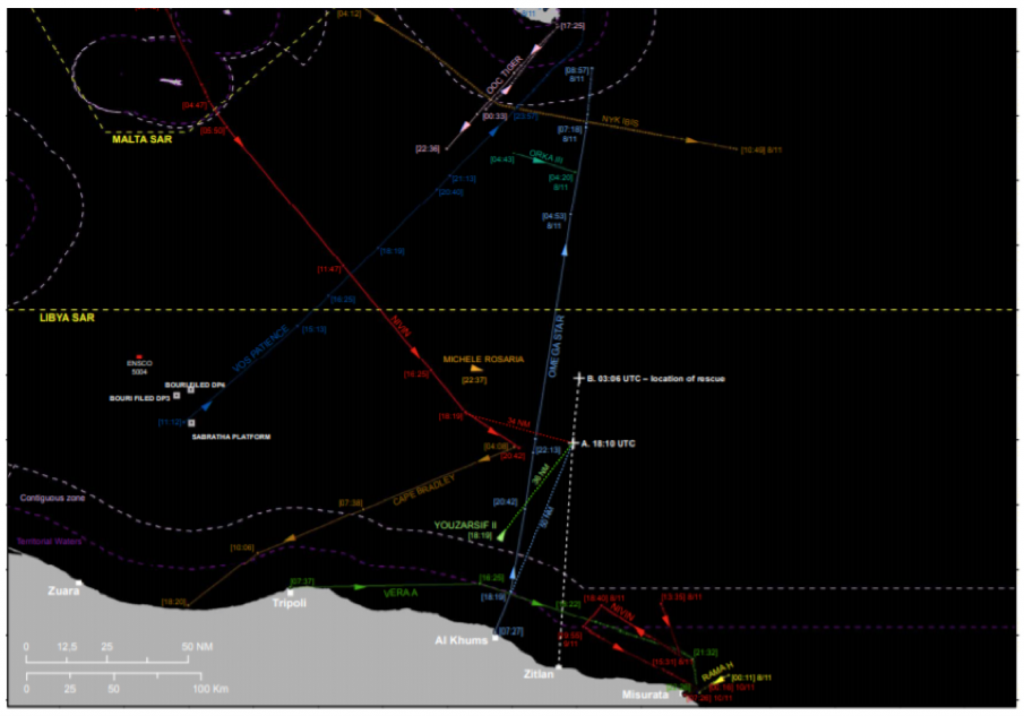
Synthetic map of the 7 November 2018 Nivin incident on the basis of georeferenced positions and AIS data. Figure by Forensic Oceanography. GIS analysis by Rossana Padeletti.
The map shows the 93 migrants’ boat trajectory as determined by two georeferenced positions, and the AIS tracks of vessels in vicinity.
One case related to the privatisation of push-backs occurred on the 30th of November 2019 and is not included in the Forensic Oceanography report. It shows how the restrictions against NGO vessels and the danger of criminalisation prevented the transshipment of the rescued migrants to the Ocean Viking. On that day, the so-called Libyan coastguards took 30 migrants violently off the supply ship “OOC Panther” of the Hamburg-based company Opielok that rescued them in the Central Mediterranean. According to the news site InfoMigrants, OOC Panther had rescued the migrants about 70 nautical miles off the Libyan coast, near the Bouri Drilling platform, and then called for assistance of the Ocean Viking which was in the vicinity and had already 60 rescued people on board.[33] A small delegation of the Ocean Viking visited the OOC Panther and were told that the Libyan coastguards had previously boarded the ship, carrying weapons and trying to force the rescued to disembark in order to be returned to Libya. According to MSF, there was an atmosphere of panic on board, and two of the rescued had jumped overboard but were rescued. Another man doused himself with fuel and threatened to set himself alight. SOS Mediteranée stated that the Ocean Viking was unable to take the rescued on board as maritime authorities would not permit it.
This case highlights the dilemma that merchant vessels frequently face. Companies like Opielok whose ships had rescued thousands of migrants in 2014/2015 and brought them to Europe, are now under pressure to hand them over to the Libyans.[34] In March 2015, ship owners associations demanded in a letter support from the heads of states, as “all EU and EEA Member States have a collective responsibility to prevent the loss of thousands more lives” and merchant vessels were not able to rescue all those they encountered in distress following the end of the “Mare Nostrum” operation.[35] Currently, discussions between German ship owners, SAR NGOs as well as the Alarm Phone have started that seek to address such dilemma and advance collaborations against death at sea and push-backs to Libya.
The OOC Panther case is one more example that shows that migrants try to resist their return to Libya. We have documented such cases before, for example when they refused to disembark from the Nivin or the Lady Sham (20 January 2019). Though ultimately in vain in these cases, there were other situations where migrant resistance prevented forced returns to the Libyan hell, for example the Vos Thalassa case from the 8th of July 2018, or the El Hiblu1 case from the 25th of March 2019. The latter case is still subject to court proceedings in Malta where three teenagers stand accused of several major crimes. The lawyers of the “El Hiblu Three” have requested their release on bail, precisely seven months after the first unsuccessful request, with Judge Aaron Bugeja finally granting the request on November 15. The three teenagers, who have not been convicted, are allowed to go free now under a variety of severe restrictions. Nevertheless they still face the risk of a long sentence in prison if they are found guilty.
In a collective press release, several organisations, including the Alarm Phone, demanded freedom and protection for the three young people who not only saved themselves but also prevented 105 fellow humans from a horrible fate in illegal and inhumane Libyan detention camps:
https://sea-watch.org/wp-content/uploads/2019/11/Statement_BailDecision_EH3.pdf
V. Messages from behind Bars
“Better die than go back to Libya!” – we often hear such desperate expressions from people in distress when they reach out to the Alarm Phone. Over recent months, we have received more and more calls directly from inside Libyan camps and the people calling us report of their horrible situation.[36] The imprisoned tell us about cruel violence, serious health issues, miserable living conditions, and feelings of constant fear. They also tell us that they feel alone and abandoned, with nobody there to help them.
“We are being starved to death” is written with tomato paste in English on a mattress. A picture, taken in May 2019 with a hidden smartphone, shows a dark hall with piles of rubbish, and over 200 exhausted Eritrean men wearing shirts with crosses painted on them with tomato paste.[37] The detained of the Zintan camp mobilised this protest to address the outside world and demand help and freedom. Similar pictures of the protest were published by several international newspapers.[38] These disturbing scenes and testimonies are not an exception. Due to the relentless protests and attempts to reach the public, the imprisoned stubbornly and bravely relay their plight, often via social media. Over the years, many accounts of the brutal conditions inside Libyan camps have been made public – written testimonies, pictures, video messages.[39] Testimonies of the air strike on the Tajoura camp in Tripoli or of the shootings in Qasr bin Ghashir were among the most dramatic accounts that reached the international media and yet: the conditions do not change.[40]
Abuse in Detention and the role of International Organisations
For a long time now, and as recent reports have revealed once more, the imprisoned have accused UNHCR Libya of neglect, of ignoring their plight and their demands, of failing to speed up registration procedures which are required for resettlement, and of being implicated with those running the camps by covering up abuses. [41] UNHCR interventions in Libya are limited – most of the camps officially run by Libyan authorities are effectively controlled by militias. Yet, what is emphasised in public are the allegedly ‘successful’ evacuations of migrants out of Libya – a fig leaf for the EU on which the UNHCR depends financially and in terms of cooperation.
Many of these evacuations do not lead to transfers into EU countries, but instead to countries of the Global South, particularly in Africa, such as Niger or Rwanda, where most refugees are stuck: they are waiting to receive asylum or get transferred to third countries.[42] In 2019, UNHCR assisted 1,410 refugees via evacuation programs and another 764 refugees in transferring to EU member states and Canada via resettlement.[43] Also IOM’s ‘voluntary returns’ to countries of origin are celebrated in Europe when very often there is little ‘voluntary’ about these returns. Until the end of December 2019 more than 9,600 people were returned to African and Asian countries, often back to a precarious situation. Many then decide to leave again, often again toward Europe.[44]
The huge delays in UNHCR managed evacuations prompted hundreds of migrants over the last months to come to the new UNHCR “Gathering and Departure Facility” (GDF) in Tripoli to demand progress on their evacuation. Many others stay in the facility as they need shelter and lack an alternative safe space in the war torn region, also as some of the detention centres where they were locked in before were destroyed. The UN agency decided to close its centre in the beginning of 2020 as it is not able to maintain the overcrowded centre. To force the people out, the UNHCR already stopped the food supply and is offering material support only to those who agree to leave.[45]
VI. The Left-to-Die Trial in Rome
The shipwreck on the 3rd of October 2013 near Lampedusa with over 360 fatalities has remained in our collective memory but much less so the shipwreck that occurred only eight days later. On the 11th of October 2013, over 250 died at sea. Many women, men and children drowned, even though the Italian and Maltese coastguard had been alerted several times to the impending disaster. From the boat in severe distress, a Syrian doctor pleaded desperately via satellite phone for rescue, but the authorities did not react adequately to his SOS calls. Instead, and over hours, the Italian and Maltese authorities argued over whose responsibility it would be to rescue. When rescue vessels arrived five hours later, the boat had already capsized and many people had already drowned.
Six years later, this case of a deliberately delayed rescue operation will be examined before a criminal court in Rome. Several officers of the Italian coastguard and the navy stand accused. Besides the delay in coordinating rescue, an Italian navy vessel had been in the vicinity of the drama but failed to intervene. Several of the survivors, who lost family members, have joined the legal action. They hope that this injustice and deadly act of non-assistance will not remain unpunished.
Here you can find our full statement on the trial:
https://alarmphone.org/en/2019/12/02/left-to-die-trial-in-rome/
VII. Fourth Meeting of the Palermo Charter Process in Bologna
In Bologna, a group of rescue NGOs, civil society organisations, activists, and representatives of European municipalities came together between 28-29 November 2019 to strengthen our work in the Mediterranean Sea and the transnational collaboration between solidarity cities in Europe. Our network emerged in Palermo in 2018 and in the spirit of the Charter of Palermo, with its central demand for the right to mobility. Our slogan continues to be: “From the Sea to the Cities!”
This was the fourth meeting of the Palermo Charter Platform Process. We fight the on-going violence produced by the European border regime, seek to foster corridors of solidarity for migrants to reach their desired destinations, and take part in the building of welcoming cities of sanctuary all over Europe.
After Palermo, Naples and Barcelona, we gathered this time in Bologna, one of the cities where the rescue organisation and movement Mediterranea was born in 2018 and where thousands currently take to the street to fight against Salvini and his Lega Nord.
Here you can find our full statement on the meeting:
https://alarmphone.org/en/2019/11/29/fourth-meeting-palermo-charter-platform-process-in-bologna/
______________
[1] https://sea-watch.org/wp-content/uploads/2019/11/Statement_BailDecision_EH3.pdf?fbclid=IwAR2WlGvCdhGV_ZpPSMefJi4XB8XYgp-sA_ryNmvHIlFH2DNjtYZnwDYOq9Y
[2] https://twitter.com/openarms_found/status/1181105347454521344
[3] https://twitter.com/MSF_Sea/status/1183155170093535234,
https://twitter.com/MSF_Sea/status/1183373679276843008,
https://twitter.com/alarm_phone/status/1183361278120738816,
https://twitter.com/MSF_Sea/status/1197132224652619780
[4] https://twitter.com/alarm_phone/status/1188068966020845573?s=09
[5] https://twitter.com/MSF_Sea/status/1196713347015675904,
https://twitter.com/alarm_phone/status/1196720346780581888,
https://www.aljazeera.com/news/2019/11/ocean-viking-rescues-94-people-libya-coast-191119115225387.html
[6] https://twitter.com/alarm_phone/status/1200074764460666883,
https://twitter.com/seaeyeorg/status/1200117831364419585?s=19,
https://twitter.com/alarm_phone/status/1200198403566850048,
https://twitter.com/msf_sea/status/1200183530204073984?s=12
[7] https://twitter.com/alarm_phone/status/1208345147756490758
[8] https://twitter.com/alarm_phone/status/1208736731425640448
[9] https://twitter.com/alarm_phone/status/1210486404633055232
[10] https://twitter.com/seaeyeorg/status/1201492542199611395,
https://twitter.com/alarm_phone/status/1202279626019680257,
https://twitter.com/SOSMedIntl/status/1202243954256859136,
https://twitter.com/seaeyeorg/status/1202646949062758400,
https://twitter.com/MSF_Sea/status/1189158719801774080?s=09
[11] https://twitter.com/seawatch_intl/status/1211583845964943363
[12]All figures are minimum values. We have to expect that the estimated number of undetected/unreported cases is much higher. Especially when it comes to interceptions by the LCG we assume many interceptions remain hidden.
[13] https://twitter.com/alarm_phone/status/1183634134071201792
[14] https://twitter.com/alarm_phone/status/1183842900058226689?s=09,
https://newsbook.com.mt/en/malta-fails-to-assist-75-people-in-distress-alarm-phone,
https://www.maltatoday.com.mt/news/national/98045/malta_requested_to_rescue_75_people_at_sea#.XaXxSc6P6P,
https://morningstaronline.co.uk/article/w/activists-slam-malta-delayed-rescue-of-refugees-who-were-adrift-at-sea-since-sunday
[15] https://twitter.com/alarm_phone/status/1185306383840878593,
https://apnews.com/24b51f7a5aa54441bedb9a04fa9d6b9b,
https://www.spiegel.de/politik/ausland/fluechtlinge-im-mittelmeer-schwere-vorwuerfe-gegen-malta-a-1292966.html#ref=rss,
https://www.infomigrants.net/fr/post/20377/malte-permet-a-des-garde-cotes-libyens-d-entrer-dans-sa-zone-de-sauvetage-pour-intercepter-des-migrants
[16] https://alarmphone.org/en/2019/10/23/back-to-the-libyan-warzone/
[17] https://timesofmalta.com/articles/view/exposed-maltas-secret-migrant-deal-with-libya.748800,
https://uk.reuters.com/article/uk-europe-migrants-malta/malta-has-deal-with-libya-coastguard-over-migrant-interceptions-report-idUKKBN1XK0BH?fbclid=IwAR2srjx9sgy0FQ52CyS6_0GjMVRy9YFvuuR3lo8u_2PtW4wME7UveFT1374
[18] https://twitter.com/alarm_phone/status/1197604829398491136
[19] https://twitter.com/alarm_phone/status/1201770593269493761
[20] https://forensic-architecture.org/investigation/nivin
[21] http://www.ansa.it/amp/sicilia/notizie/2019/10/07/migranti-naufragio-davanti-lampedusa_d819636e-8900-400d-a286-bd6efd7d1b70.html?__twitter_impression=true,
https://twitter.com/alarm_phone/status/1198305632937484288
[22] https://alarmphone.org/en/2019/11/26/four-days-of-struggle/
[23] “After Ocean Viking sent a request for a Place of Safety, Libyan JRCC offered Tripoli as a Place of Safety. Ocean Viking refused Tripoli as a Place of Safety since Libyan ports do not conform to the definition of a Place of Safety and requested a Place of Safety to ITMRCC and MTJRCC” https://onboard.sosmediterranee.org/sections/operations/ocean-viking-215-survivors-19-november-2019-disembarkation-messina/
[24] SAR convention Annex 2.1.7: “The delimination of search and rescue regions is not related to and shall not prejudice the delimination of any boundaries between States“. Libya didn’t sign the SAR convention, though.
[25] https://treaties.un.org/Pages/ViewDetails.aspx?src=TREATY&mtdsg_no=IV-9&chapter=4&clang=_en Convention against Torture and Other Cruel, Inhuman or Degrading Treatment or Punishment (Art. 3,1)
https://treaties.un.org/Pages/ViewDetailsII.aspx?src=TREATY&mtdsg_no=V-2&chapter=5&Temp=mtdsg2&clang=_en Geneva convention Art 33 (1)
[26] https://eumigrationlawblog.eu/wp-content/uploads/2017/10/MEMORANDUM_translation_finalversion.doc.pdf
[27] https://timesofmalta.com/articles/view/exposed-maltas-secret-migrant-deal-with-libya.748800
[28] EunavforMed claims to have enabled the LCG to intercept 19,775 people in 2017, 12,852 in 2018 and 7,021 in 2019 (as of 30 October) https://www.internazionale.it/notizie/lorenzo-bagnoli/2019/11/13/italia-libia-guardia-costiera?fbclid=IwAR02YWSureAqJF1g69QAAzjDnWiqosfJePIIOj6zxZVSMU34wZ1-unBBjac
[29] Alarm Phone Press Release: Back to the Libyan Warzone – How Malta Instructed Libyan Authorities to Intercept 50 Migrants within the Maltese SAR Zone https://Alarm Phone.org/en/2019/10/23/back-to-the-libyan-warzone/?post_type_release_type=post
[30] https://www.france24.com/en/africa/20191209-reporters-plus-libya-the-infernal-trap-conflict-frontlines-militias-tripoli-plight-migrants transcript min 15:04-15:10: “but off camera, one of the Libyan coast guard tells us they sometimes intervene in European waters.”
[31] https://forensic-architecture.org/investigation/nivin
[32] https://www.glanlaw.org/nivincase
[33] https://www.infomigrants.net/en/post/21241/rescued-migrants-taken-from-supply-ship-by-libyan-coast-guard
[34] An exception was the Asso Trenta case where people rescued by a commercial vessel were disembarked quickly in Italy. https://twitter.com/alarm_phone/status/1190951700473008130?s=12
[35] https://www.ics-shipping.org/docs/default-source/Submissions/EU/attachment-to-press-release.pdf?sfvrsn=2
[36] https://www.msf.org/libya%E2%80%99s-cycle-detention-exploitation-and-abuse-against-migrants-and-refugees
[37] https://foreignpolicy.com/2019/10/10/libya-migrants-un-iom-refugees-die-detention-center-civil-war/
[38] https://www.channel4.com/news/starvation-disease-and-death-at-libya-migrant-detention-centre,
https://www.aljazeera.com/indepth/features/urgent-refugees-perish-libyan-detention-centre-190606185251273.html,
https://apnews.com/43eb47c8ce6b4946a91f8c37f41c7cbe
[39] https://foreignpolicy.com/2019/10/10/libya-migrants-un-iom-refugees-die-detention-center-civil-war/
[40] https://www.aljazeera.com/news/2019/07/libya-migrants-recount-horrors-tajoura-detention-centre-attack-190704053421671.html,
https://www.theguardian.com/world/2019/apr/25/libya-detention-centre-attack-footage-refugees-hiding-shooting,
https://www.youtube.com/watch?v=AnCP6XCmgjs,
https://foreignpolicy.com/2019/10/10/libya-migrants-un-iom-refugees-die-detention-center-civil-war/,
https://twitter.com/GiuliaRastajuly/status/1187662343645401088
[41] Registration currently takes place only inside detention centers and is limited to nine nationalities. https://www.unhcr.org/blogs/registration-is-a-right-for-refugees/. Information if a refugee gets accepted for resettlement takes 1-2 years and can only be provided out of detention, not outside. UNHCR in Libya part 1-4: https://www.euronews.com/2019/10/02/unhcr-in-libya-part-1-from-standing-withrefugees-to-standing-withstates
[42] In December 2017 Niger accepted up to 1,000 refugees from Libya via Emergency Transit Mechanism (ETM): https://taz.de/Fluechtlingslager-in-Niger/!5587976/. “Since 2017, more than 2,900 refugees and asylum-seekers have been evacuated to Niger, but while EU has promised to provide safe pathways and EU countries have agreed to host them, the resettlement promises are not respected”: https://twitter.com/saracreta/status/1206572587947565057. For a detailed study on the effects of ETM and resettlements to Niger by ASGI see: https://www.statewatch.org/news/2019/jul/ASGI%20Resettlement%20ETM%20-%20ENGLISH.pdf
In September 2019 Rwanda agreed to take up to 30,000 refugees from Libya via ETM. About 100 people arrived in Rwanda until September 2019: https://www.theguardian.com/global-development/2019/sep/10/hundreds-refugees-evacuated-libya-to-rwanda
[43] https://de.euronews.com/2019/09/13/unhcr-rettet-knapp-100-fluechtlinge-aus-libyschen-gefangenenlager#.
In 2019 to date of Dec 6th, 2,184 refugees and asylum-seekers have departed for solutions out of Libya, including 774 under resettlement and 1,410 under the evacuation programme: https://reliefweb.int/report/libya/unhcr-update-libya-6-december-2019-enar. Germany welcomed 9 people from Libya via resettlement in 2019: https://resettlement.de/aktuelle-aufnahmen.
[44] 8,946 migrants were returned to Africa and Asia by IOM until Nov, 30th 2019: https://www.iom.int/sites/default/files/situation_reports/file/iom_libya_update_16-30_november_2019.pdf.
In 2019, IOM’s Voluntary Humanitarian Return (VHR) programme has so far assisted more than 9,600 stranded migrants in Libya to return home: https://twitter.com/IOM_Libya/status/1208002841656406016
[45] https://www.thenewhumanitarian.org/investigation/2019/12/10/UN-migrants-Libya-transit-centre-project?utm_source=twitter&utm_medium=social&utm_campaign=social,
https://www.theguardian.com/global-development/2019/nov/28/refugees-being-starved-out-of-un-facility-in-tripoli,
https://apnews.com/7e72689f44e45dd17aa0a3ee53ed3c03